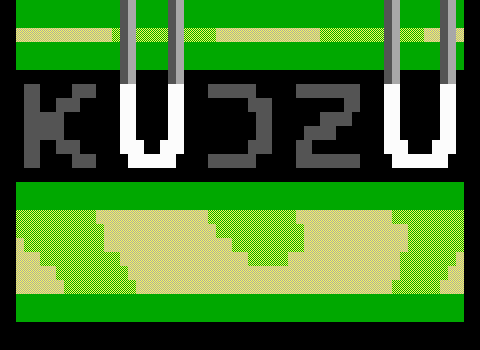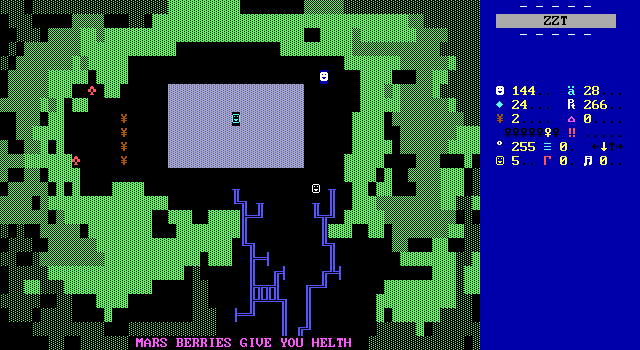A few ZZTers have "eras" to their work, a visible change as the author's ideas of what to create develop. Janson's got her early adventures that strongly parallel early official releases. The Secret of Cannibal Island vs. Best of ZZT: Part I, Dungeons 2 to well, Dungeons, The Three Trials to Best of ZZT: Part II. Hydra's early output has its heavy adventure-game inspirations, with fan-made games based on Sierra titles resulting in King's Quest ZZT, Quest for Glory, and Indiana Jones games before moving to games adapting modern life to game form with Redlight Zone and The Life of a Scotter.
Commodore is no exception. Starting with some (un)licensed (and adjacent) fan games with Ghostbusters and The Living Dead before finding his footing with a series of engine-focused games each more impressive than the last. Frequently setting new standards for genres with Sid's Disaster, Angelis Finale, Psychic Solar War Adventure, and creating a brand new kind of side-scrolling adventure with CAT, CAT, THAT DAMN CAT.
And that's without getting into the only recently discovered prototype of Space Fork, cramming a space exploration game with Super Star Trek combat into ZZT.
So where do you go from there?
For Commodore, there's the occasional release that's a love-letter more than anything. More simple games that try to capture the feeling of more classically styled ZZT adventures. Starting with The Challenge, focusing on action and high score chasing in a world that would fit right in with the ZZT's Revenge pack. Later, really creating something special with Super Archaeologist Simulator, mixing gorgeous visuals with early ZZT's sense of humor, as well as a combination of master-class puzzles and action scenes to create one of ZZT's best adventures.
And then... KNIGHST OF MARS with its deliberate spelling errors, yellow borders, and programming errors.
Obviously Commodore knows better. This is of course, a parody of your typical newbie ZZT worlds. There's been plenty of them over the years. Most recently, I looked at MegaZeux Adventure, which had plenty of fun with deliberately bad design that it would attribute to various 90s ZZT community punching bags be they ZZTer, Bill Gates, or the band Hanson.
These kinds of games usually reach for the fruit hanging lowest. And for a game from 2015, in a year almost complete devoid of new releases, Commodore's parting gift to ZZTers could easily be disregarded as an unfunny joke decades past its expiration date. At least, that's what I thought going in. After all, the genre of newbie game parody isn't really something you can innovate in. Breaking the rules of good taste are what make such games anything to begin with. You can't make them better, and if the goal is to make them the worst, how low can you really go?
On the surface, Knights of Mars (I'm not going to replicate the typo every time, my spell checker and I will go insane,) appears to be one more game that looks at the complaints to be had in game the classic ZZT game design guide ZZT Syndromes and tries to include as many of them as possible. Yet by the end of this little adventure, I realized not only did Commodore secretly create a proper adventure, he did so while capturing a number of far less obvious marks of amateur ZZT games. This game isn't so much bad on purpose as it is purposely trying to make you think that it's bad.
Commodore writes that this game was created in three days, a measurement of time that ignores the years spent playing ZZT games, seeing how the ways in which new authors are shaky, and capturing not only the ways they stumble, but they ways they create free of the burden of worrying about the audience. These games are for the authors first. The question is, what does Commodore want to make?

The Usual Offenses
While it innovates well beyond the obvious, Knights of Mars out of necessity still needs to tick the boxes of a newbie game. Nobody's going to laugh when they see a yellow border, but to make a game like this without them would completely change how people perceive it. Would a deliberately poorly made game, that avoids the most obvious tell of a poorly made ZZT game, still be treated as such? Or would it be a baffling retro game that captures the flaws for historical accuracy, but forgets to capture the charm as well?
I don't know what such a thing might actually feel like to play. And Commodore isn't going to give us an answer for that.

The title screen says it all really. Before you even start the game, your eyes are overwhelmed with obvious tells of what to expect. Default yellow borders? Check. Shareware, implying future nags to register? Check. A misspelled title. A gap in the fake wall floors indicating where the player is hidden on the title screen. A passage indicating that players are going to needlessly start the game on the title screen. Check, check, and check.
Players are treated to ten boards of walls that are a rigid yellow or a chaotic mess of terrain meant to represent Mars.

The quest (if you can call what the king says that, more on that later) is to slay a Martian dragon in the cave west of town. Fortunately for the knight, this task isn't exactly difficult. Commodore's dragon fight is right at home among oversized ZZT enemies that do a better job of looking imposing than actually threatening players. This big guy joins the ranks of other such bosses like giant Darth Vader, giant Bowser, and giant eagle.
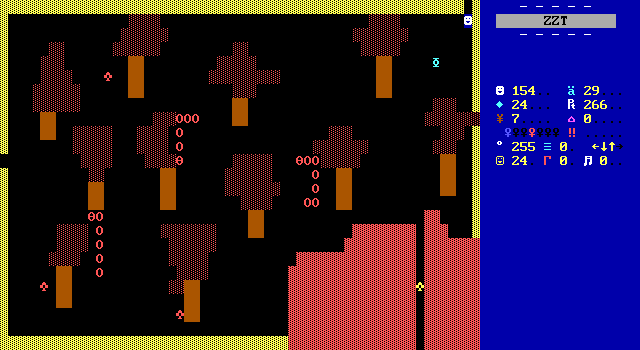
The dragon isn't the only instance of a challenge becoming deliberately underwhelming. The game has a puzzle with a rockdemon that blocks the only path up the mountain. Touching the demon warns players that if they aren't careful, they'll be eaten by the creature. In order to pass, the player needs to collect enough gems to feed the rockdemon, giving him heartburn before he runs away.
I use the term "puzzle" lightly.
Still, this kind of obstacle isn't anything unusual. Shoot, Town requires players collect gems to be able to pass its bridge troll. This is tradition. The puzzle's implementation is where it gets a bit more true to form.
You see, in order to visit the forest and reach the rockdemon, players need to first acquire a yellow key. That key is acquired here:
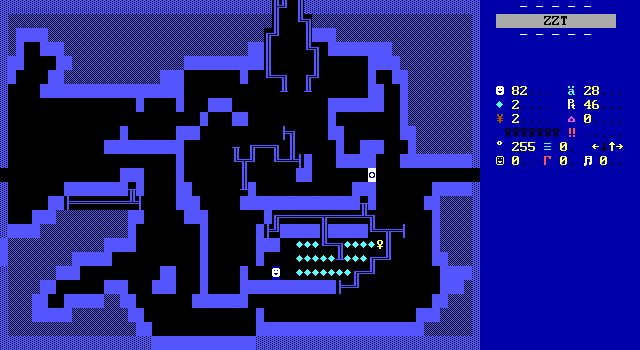
You need ten gems to get past the rockdemon. Can you solve the puzzle and figure out where to find ten gems??
Needless to say, this is an instance of a puzzle being solved before players even know there's a puzzle in the first place. It's a good touch, probably not anybody's first thought for what a newbie game would do, yet one that anyone who's played a few will inevitably run into.
Chef's (of Mars) Kisses
Commodore does so much more though. As somebody that's now streamed hundreds (well, it feels like that many) of ZZT games that don't do much of anything correctly. I feel like I'm in a pretty unique position to take in everything Commodore is doing, regardless of subtlety, and weigh in on its authenticity. I have stared into this abyss, therefore, I know what an abyss looks like.
Although Commodore already won me over with the title screen alone, the very first thing players get to do when the game properly begins in town let me know that I was in for something special. An opening scroll provides the story, and just a few spaces away the first NPC is ready to be interacted with.

They scream at the stranger, not recognizing them as a knight, and shoot bullets every which way. Despite firing counter-clockwise starting from the north, I was flummoxed enough to still be shot. After all, why on Earth Mars would I have my guard up before even starting the adventure? You'll wind up going the rest of the game with an inherent distrust for everything you come across. It's a fantastic trick to keep the player on edge of what is ultimately a rather simple game.
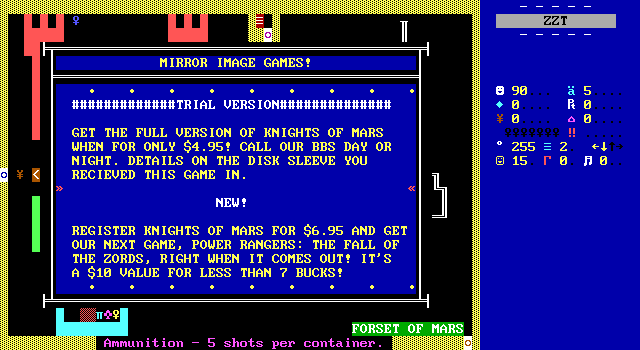
As noted on the title screen, the game calls itself shareware. This is an easy gag to include in any deliberately poorly made game, suggesting that somebody would play it and want to spend money on it afterwards. Commodore's shareware bit is a tad more than tacking on UNREGISTERED text and asking for cash.
Commodore uses the shareware concept to put out the idea that there's more than just Knights of Mars in this low-quality gaming universe. Soon after starting, players will discover a scroll with the pitch to register the game. This helps cement what era of ZZT in particular the game is trying to mimic, with pleas to call the author's BBS at any time and to check the disk sleeve of the game for contact info.
For a mere $6.95, not only will you get the registered version of Knights, you'll also get the upcoming Power Rangers: The Fall of the Zords. It's another nice touch. Kids making ZZT games have a hard time not including the things they love in them, so it's almost surprising that there are no power ranger cameos to be found here, just a plug for this upcoming game.
There's also the added detail of the games having arbitrary values assigned to make them sound like better deals. It really drives home the idea that a child made this. They've heard "An $X value, for only $Y.99!" and replicated it, because that's just how you sell things to people.
Really the only thing off about this is that the game doesn't include a phone number, family e-mail address, or actual mailing address to send your check or money order to. I can forgive him for that readily enough. By 2015, putting in a real address even if it's not yours would have been a no-no. Putting in a blatantly fake one would break the illusion that this isn't a 2015 Commodore game, but a 1995 Commodore game.

Commodore's commitment even reaches the parts of the game players are unlikely to ever see. There's a whole let of caps lock visible in the game's text, with even more in the code itself. Nearly every instance of code in the game is written in uppercase. It's an incredible amount of dedication that isn't even on display.
This stems from ZZT's own help files listing every command in capital letters. Nothing in ZZT-OOP is actually case-sensitive, it's just a way to better highlight what is a command and what's a text. A stylistic choice that I follow when writing on this site as well even if I would never actually write #SHOOT SEEK like that in an editor.
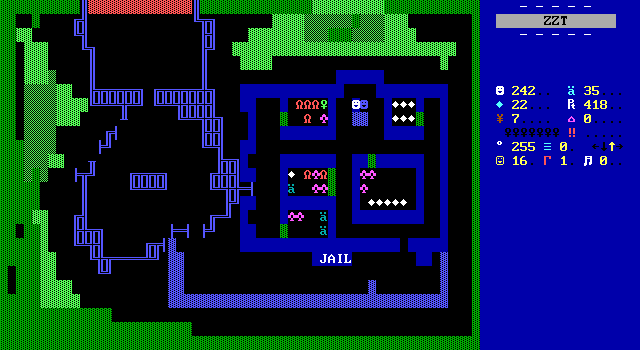
Near the end of the game when players reach the jail that just happens to be there, it gets to the point where the care put into the code left me wondering if I was looking at scrapped plans, or continued dedication. A blue person sitting at a desk has no reaction to anything players do. Yet they still have some code:
@man
#end
:touch
And that's it. Three lines that will never be seen without editing the game, yet they hint that there was perhaps to be something more? Is this Commodore not having any idea what the man should do? Is it a sign of a newbie game where plans are made, yet never implemented? I cannot say. I can only wonder if the idea someone might one day see three lines of code that do nothing is meant to be a gag or not. I have seen your man Commodore, and I have laughed at his NOP.
Another often overlooked aspect of early ZZT worlds, and not just the bad ones, is this weird idea that the game should react if players shoot things that don't have any reason to be shot. At least one early game, The Crypt, tries to turn unprompted murder into a gameplay mechanic by having it mark your character as evil, changing how humans and demons react to you.

Commodore goes for soft punishment instead. You're welcome to shoot anyone you like. Some characters won't react at all. Those who do, have a universal response: a gory end by turning into a red slime.
It's an age-old trick to produce a blood splatter. ...When it's accompanied by another object changing the slime and its breakable trail into fake walls. No such luck here. Instead, any unwarranted killing will quickly fill the room with breakable walls as the default speed for slimes is the maximum.
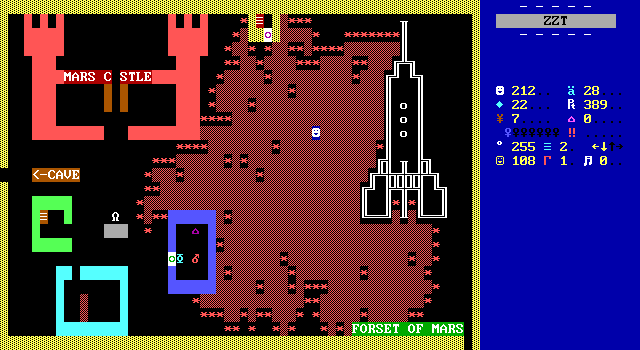
While Commodore provides enough ammunition to deal with the game's monsters, there's no mercy if the player wants to be a monster themselves, leaving them to contemplate their actions while being unable to escape the slime.
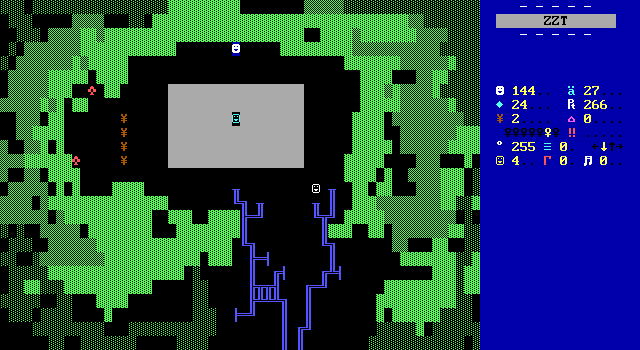
Speaking of things you don't need to do, players will never need to light up a dark room. You won't find any on Mars. What you will find though, are plenty of torches just in case.
Commodore turns torches into a running gag, making sure to provide one to the player in the initial pile of supplies in the castle, one outside the cave that you would immediately take as a sign that it's going to be a dark room, and then a small pile outside one of the cave's exits.
I'm dumb enough that I didn't even notice until looking at screenshots and realizing I had torches. I still think it's a fantastic joke.
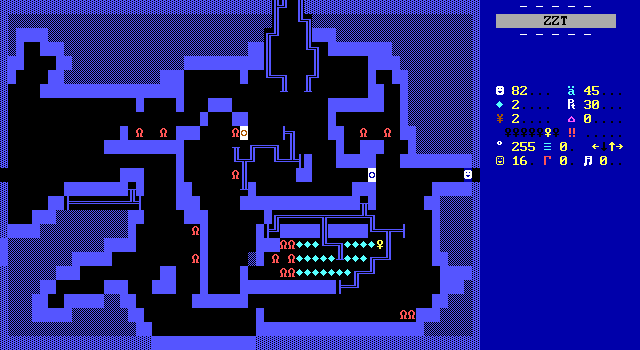
A more cruel joke is this damned door.
The worst thing in a poorly made world is the player running around with extra keys, never knowing if you were supposed to use it and are about to be blocked by a key later, or if you were supposed to hold on to it for thirty boards. When you come across something like this, a door that doesn't need to be opened to get to the other side, it's a horrible source of anxiety.
Eventually, I gave in and opened it, and confirmed that it is just a helpful shortcut that opens up, with a lot of anxiety as baggage for doing so.
On The Nose
As good as it may get, not everything Commodore does with Knights of Mars resonates with me. There are a few decisions that come off as unfounded stereotypes which while you can imagine somebody doing, finding evidence of such things having been done is another story. It's easy to forget sometimes as you're wandering through an eight board maze of identical screens or solving a Town-esque bank vault by pushing sliders so far back that players can get inside without entering a combination at all, that more than anything else newbie games are authentic. None of these authors ever set out to make their very first video game a bad one.
They are creating in earnest. Every pile of star throwing tigers. Every board with a five second time limit. Every #give red key command that produces an error is there because they author thinks that this will work, and work well.
It's when you overlook these good intentions that a newbie-styled game starts feeling less like the real thing. When you start to think about what to include to make the game bad rather than what thinking what a beginner would include that you inevitably leave your own tells that the experience is secretly a charade. If I hadn't heard of Commodore before, and this was my introduction, I'd likely still believe the whole thing to be authentic overall. There's certainly a first time for everything.
Now, if you gave me some AOL-era newbie-made games along with Knights, then asked me to find the one that was actually made in 2015, I think I could figure it out. Maybe that's me bragging, but I have some confidence at least.
One considerable tell is that all text in the game (save a single object) is written in all-caps.
There are games that are mostly in all-caps. The borderline-100% consistency seen here though? Not so much. That level of commitment seems to be a rarity. Given the short length of the game, it's not impossible for something like this to use no lowercase letters, but it is a bit suspicious.
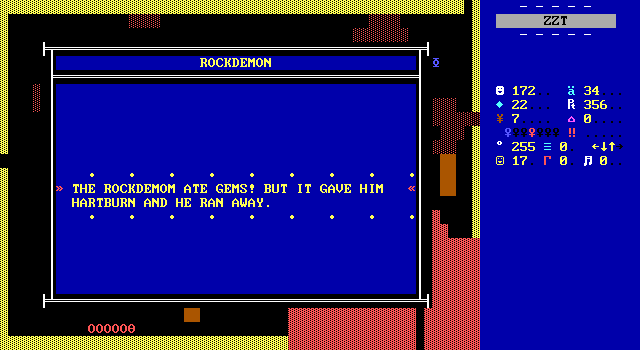
Similarly, some of the intentional misspellings also take things a tad too far. "Hartburn" I don't buy. Too common of a word, with too basic a spelling. Now, I would absolutely believe a 90-s era World Wrestling Federation game made a kid might have a wrestler named "Brett Heart". The other way around is more of stretch.
Other typos fit the part better. The game consistently writes mountain as "mountin". Sure, that's how you say it!
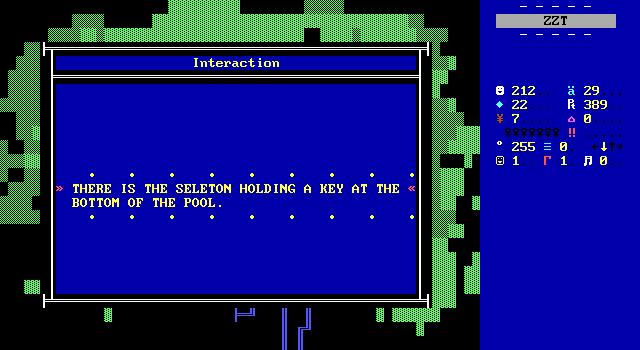
Skeleton becomes "seleton", missing a syllable too pronounced to go unrepresented in some form. Skelton, Skelitin, Scellaton... plenty of viable options in my eyes that better fit the word's pronunciation without much enunciation.
Forest becomes "forset", a believable typo were it a one-off and not written that way both in messages as well as on-board text.
Most blatantly deliberate, though admittedly unlikely to be seen due to the structure of the game, is the rockdemon who is described as being "HUNGARY". That one is about as on the nose as it can get.
So yeah, the game's text as whole gives the game away. I don't think any of these misspelling are particularly funny, certainly not funny enough to be worth the hit taking to the believability of what you're playing.

Perhaps the most obvious tell of all is the faux-corruption in the king. This does a great job of setting the expectation that this game is deliberately going to be busted in numerous ways. It's just not how corruption actually looks in ZZT.
Rather than repeating bits of the binary parsed as text or having lines escape from the message window, Commodore writes out some actual hexadecimal values with a smattering of special characters. The aesthetic is certainly there. This feels like a broken game. This kind of broken however is taking something whole and smashing it up. It's not the same as a game that's unplayable because it was put together poorly in the first place.
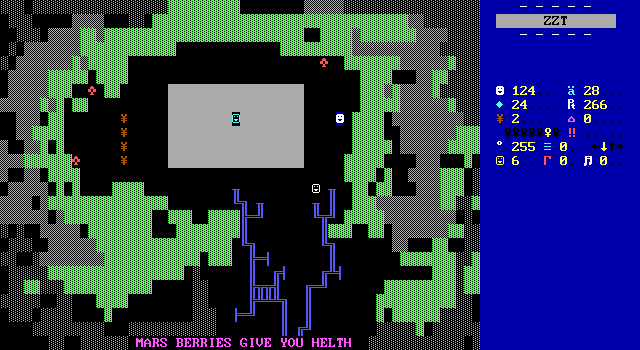
For a newbie game, Knights of Mars is surprisingly kind about giving players sources of health. "Mars berries" are used throughout the game, exactly as they would be used in any game that wants to be seen as well-designed. There's a shocking lack of giant piles of items to grab. The berries here, may be better replaced by placing annoying numbers of gems to collect instead.
To actually use an object as a healing source, and one that appears regularly, is better than Tim Sweeney was doing with the original ZZT games that rely exclusively on gems, a single shop in City, and one board in Caves that has a whole bunch of heart objects that are then never seen again.
Our theoretical author does use a fair amount of programming, and it's mostly functional to boot. This is the kind of game where an early object should have just dropped five hundred health and ammo on the player and sent them on their way.
Actually spacing out supplies like this gives the action a more engaging give-and-take in contrast to negating all challenge by giving the player more items than they'd ever need. It's possible to get severely hurt on Mars. You can genuinely die in this game if you aren't careful, and early on there's a believable possibility of running out of ammo if you aren't at least trying a little bit to make it last.
That there's any effort put in the game's balance at all makes the game more competent than its peers.

At times, the game also manages to become a little too wacky for its own good. Plenty of young authors emulated what they saw in other ZZT worlds, asking for money, promising a registered version with exciting new features, special cheat codes, maps, guides, and such.
Commodore's idea of using the un-fulfilled promise of an animated boss fight in the registered version to lessen the sting of an immobile enemy is certainly a valid tactic. The author gets to disguise their inability to make (or in this instance, ZZT's near-impossibility of making) a large-scale and mobile opponent behind the smoke and mirrors of a registered version. The game isn't as good as it could be to entice you into registering, transforming a negative into a selling point for the paid product. Our imaginary eleven year old game designer may have a future in marketing.
Still, that's not what this scroll winds up being about though! It detours into a different believable promise of more exciting and challenging boss fights, before careening off a cliff into irreverence, with some stream-of-consciousness rambling of how absurd the full game can become.

Then there's this layup that Commodore has, an absolutely effortless inclusion, yet he refuses to take the shot. You made an amateurish ZZT board where the only enemies players fight are centipedes and not one of them is as long as the board is tall?
The giant centipede is a rite of passage. Inevitably when authors are still discovering what ZZT will let them do, the allure of "how long can this thing be?" is irresistible. A siren's song to create the largest bug a board can handle. Centipedes are how players discover the stat limit exists in the first place, when that question of how long a centipede can be unexpectedly receives an answer.
But there are no such beasts here. The centipedes of the Martian forest are of perfectly average size, bending around corners, but not obstructing huge swaths of the board. Players never face the decision of whether to wait for a gap to slip by or to slice through with bullets and let the board become more unmanageable with the creation of additional centipedes.
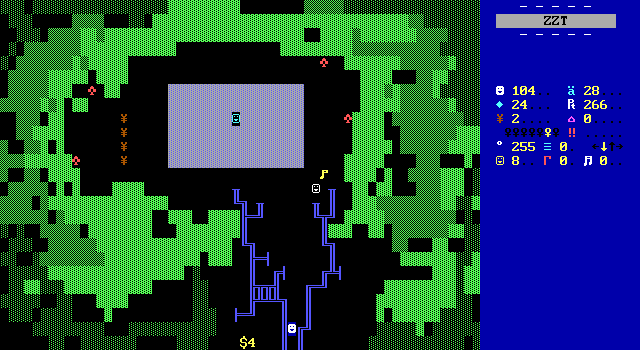
Chaotic board layouts feature prominently. Most boards feel like the walls were scribbled into place, with irregular bits of walls poking into the player's path, preventing smooth movement.
If you want to make a board feel like it's made out of spaghetti, line walls are the go-to solution.
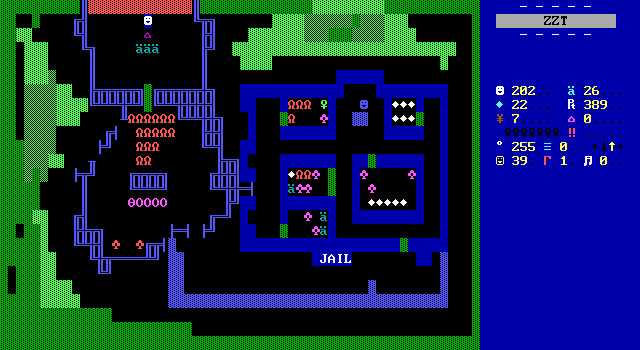
The jail though, has this one tiny insignificant little spot that sticks out to me. Do you see it?

This break in the wall here. It's still enough to keep players inside. It seems like it's something that would have been manually erased to make things look even more messy.
The newbie-style wall scribbles are made in the simplest manner possible. Turn on the editor's draw functionality, and mash keys in the general shape of your intended layout. There really shouldn't be any breaks because that implies going back to adjust things. In this case, just breaking up a wall for no particular reason.
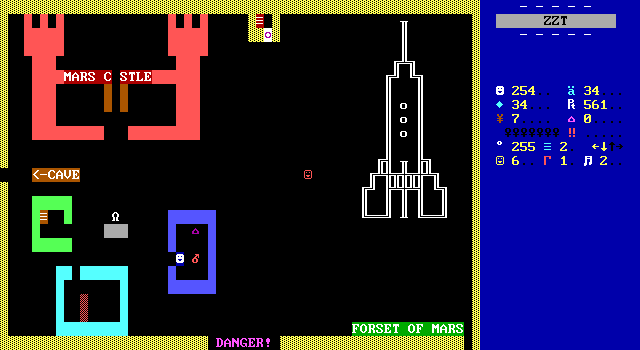
Lastly, even though this is more vibes than anything, there's a rude little trick played on the player when they blow up a fountain that I can't imagine a new ZZTer coming up with.
A single bomb can be found in a locked room in town with some major hint that its meant to be detonated near the fountain. Commodore, with his knowledge of ZZT's behavior, cruelly provides an energizer alongside the bomb. Players are tempted to grab the energizer and just let the explosion hit them, expecting the invincibility to prevent damage.
Yet energizers don't offer any protection from explosions. I can see all of this as a beginner's mistake, thinking you're helping the player out when really you're hurting them. That much is believable.
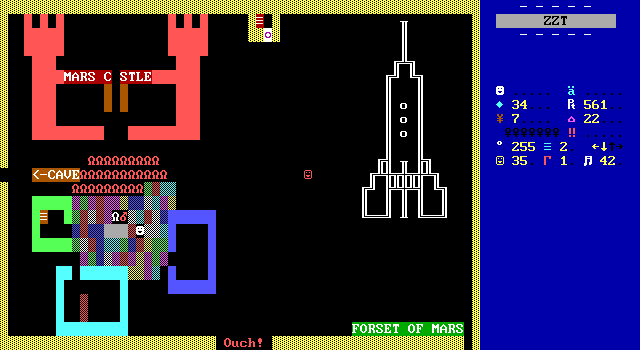
There's more to it than though, which makes the scenario too complex to believe. When the fountain is bombed, it changes the breakable walls produced in the explosion into lions! Players who grabbed the energizer as they started pushing the bomb suddenly have to make a run for it as their invincibility is almost gone and they are suddenly swarmed with enemies.
This would make for a good Oktrollberfest trick. As a move a newbie would pull, I can't see them thinking to do it. Those breakables exist for just a moment. It seems a bit too unlikely to imagine someone thinking to try and manipulate them when they've yet to grasp the basics.
Secretly Competent
At the end of the journey, I had the realization. Despite being a newbie game, Commodore did make a proper adventure here. All the gags and all the deliberately poorly designed components never actually get in the player's way.
This game even has a storyline running through it that gives some of the stranger moments in the game some purpose.

Which is a bit of a surprise, given that when you speak with the king in his castle, the dialog you see is that faux-corrupt text that I didn't find all that believable.
Where it does succeed though, is that the corruption allows Commodore to give the player the slightest motivation for their quest. This is the king of Mars. Knights are needed to slay the dragon. What more could you need?
The king gives you the key to the cave, and the knight gets to fight the dragon. Problem solved.

The story would seem to end here, with the bulk of the game still remaining. Most likely, either before or after fighting the dragon, players will take the cave's other path to a strange lake. Here, one inaccessible object is stuck in the center of the water, while a ghost hangs out nearby, humming a sad song.
Thanks to some dropped keys from the dragon, players can then go through the forest and find the sage's hut where the sage reveals more clues as to what's been happening on Mars. The musician? Dead. The maiden? Dead. The magic flute? MIA.
Perhaps the weird humming ghost is a connection.

Continuing to the mountain, the flute can be seen on its peak. Players then need to find a way to reach it. A passage seemingly coming out of the river leads to a bomb and some circles which one would assume will do something about the water.
The way here, is through the red door back in town. There's no tunnel or anything, just an immediate warp. Add "bizarre passage links" to list of accuracies Commodore includes.
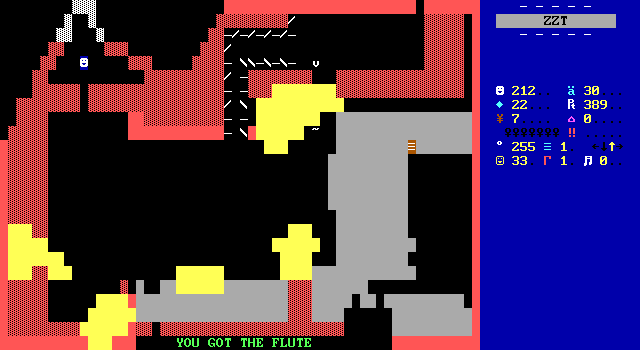
Also needless backtracking. Rather than just remove like two more tiles of water so players can reach the flute quickly. Instead you get to return to town, cross the forest, and climb the mountain. This sequence is probably the most annoying the game ever gets, which is significantly kinder that the sort of games that would serve as inspiration for Knights of Mars.
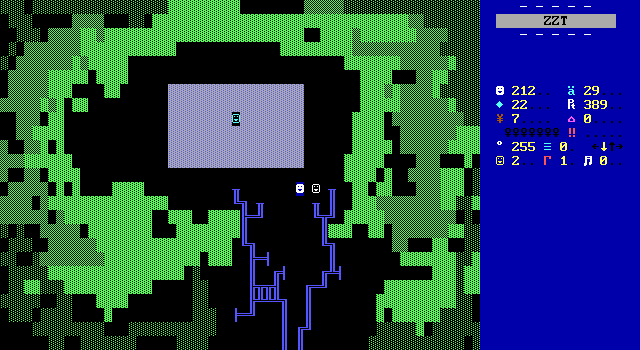

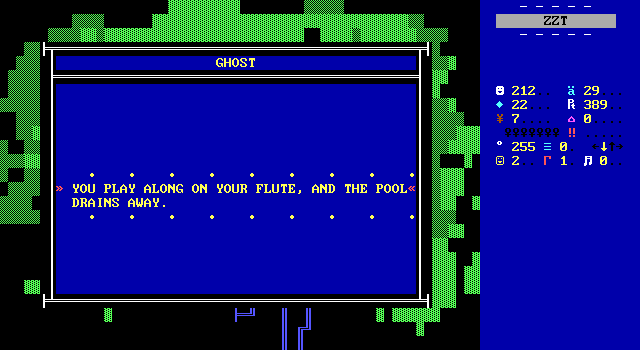
What begins as "A weird ghost is humming at the lake?" turns into a surprisingly poignant scene. A pair of lovers whose romance ended after the musicians tragic death. The maiden who then takes her own life rather than live without her beloved, and then the musician unable to find proper rest until they can play music for her once more.

You loot the body and get the key to the back of the sage's hut. What lies beyond is a total unknown compared to the signage seen throughout the game.
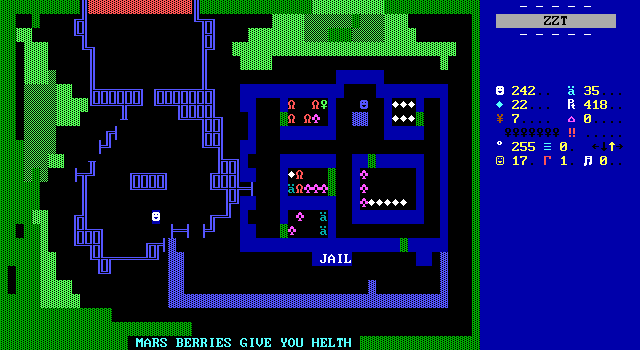
The unexpected amount of story, now resolved, dissolves completely. Behind the sage is the jail with its silent jailer. The whole point of this was to get one key to trade it for another.

Then use that key, to open up the last locked building in town. Blow up the fountain, receive one final key (and an nasty surprise of lions).
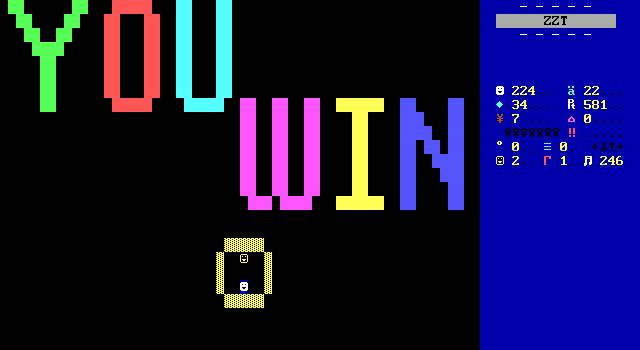
And just like that you're home free!
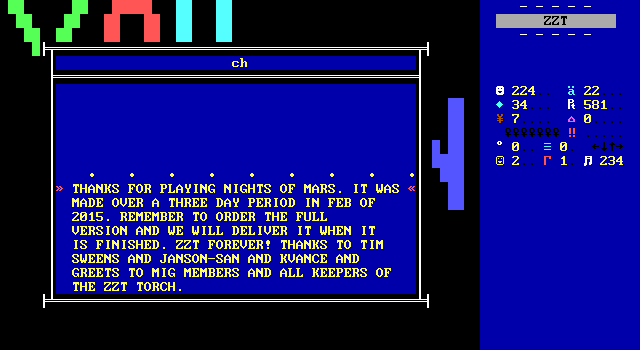
Final Thoughts
Overall, Knights of Mars is a very peculiar beast with more going on than it would seem. I get the feeling that this is in fact Commodore's attempt at setting another new standard for a genre, and doing so with one of ZZT's most unique styles of game.
It's very easy to just see the yellow borders and coast, but I can't help but see the effort put into the game. It's not just capturing the peculiarities of the "first ZZT world" game. There's a smoothness to the game. None of the bad decisions lead to frustration. The way Commodore still gives players proper amounts of supplies. The way the limited gameplay is still reasonable. The sage's hut board has some fun blink wall challenges to overcome on each trip. The polite ways to head back via transporter from the mountain or the blue door in the cave that doesn't actually need to be opened. These elements make things easier on the player, while still maintaining the aesthetic of the game being a complete mess.
This is an adventure game, start to finish. It's short, it's not much. I don't know how much a newbie-style game can be made playable, yet there's a distinct contrast here compared to the real thing. I don't believe Commodore was making this aiming to score perfect marks in accuracy. This would be an easy game to slap an alias on, and perhaps confound staff as they tried to figure out if the STK forest tiles used on one board counted enough for adherence to z2's upload requirements.
Commodore didn't hide the game's author though. His name is featured prominently in multiple places. There is no imagined child at the heart of it all. This is Commodore playing with the boundaries of acceptable ZZT games. It's impressive in its own way.
What Commodore is able to capture here that no mean-spirited newbie bashing world or anti-Syndromes game could, is the charm that comes from a new programmer creating their first work. He's able to recreate that speck of something greater that can be found in these rough ZZT worlds, through his surreal writing that's sure to crack a smile, as well as the whole maiden and musician story. Even the worst ZZT game often has something that you'll take from it, wishing perhaps that it could have executed on better. Many have overlooked such things to bring authors down a peg, but the fun of ZZT is seeing these ideas given a chance of being expressed, crudely, or otherwise.
I can't call this a "good" game. It's over in minutes, offers little challenge, and certainly does nothing that hasn't been seen a thousand times with its gameplay. Still, I do feel like maybe Commodore was the first to remember that nobody tries to make a bad ZZT game. They try to make something that people will enjoy, and despite the uphill battle it faced, Knights of Mars was enjoyed by me.

